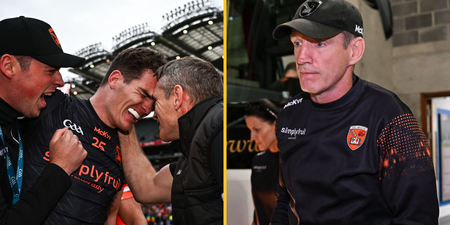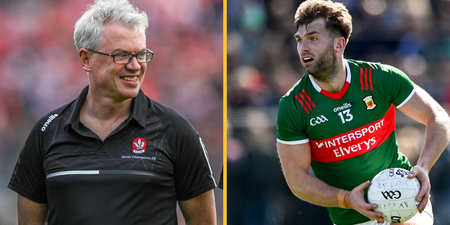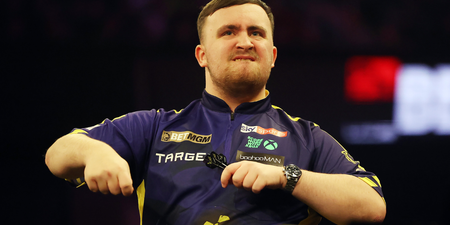A full forward’s game is all about movement.
It defines whether they get on the ball, where they get on the ball and whether they can score when they get on the ball.
Sometimes it can be tough for a full forward to know when to move, how to move and to get the balance right between the two.
The full forward line is one of the most fickle positions on the whole field. Your performance is generally defined in the short number of seconds that you get on the ball.
A full forward may only have to touch the ball once in a game to become a hero, but many full forwards are also familiar with being a zero, which often can be through no fault of their own.
When things are going wrong for a team, the full forward line generally bears the brunt, managers regularly wretch for a corner forward who hasn’t even got a ball with which to influence the game, they are subbed off and have had a bad day.
This may not be their fault, however, it should be attributed to out-field players who aren’t getting the ball into them or supplying them with any ball.
Preparation off the field is important as well https://t.co/TUJz0melCq
— SportsJOE (@SportsJOEdotie) May 19, 2017
Steven McDonnell played in the full forward line throughout his career and the Armagh man tormented many a full back line with constant variation in his movement.
Speaking on The GAA Hour Football Show on Thursday, McDonnell gave a key insight from his playing days on how he involved himself in the game, even when there was no ball coming in.
Many players throughout the country will be familiar with the feeling; you’ve been doing what you were told, you’re staying around the full forward line eagerly anticipating a ball to come in. The ball doesn’t come, doubts enter your head, ‘should I be doing more here?’, ‘what should I do?’.
You’re starved of ball and your confidence drops, you begin to not want the ball anymore, you’re afraid you’ll do something wrong when you get it.
McDonnell revealed what his response is to such a situation.
“85% of any game was spent in and around the square for me and Ronan Clarke but there was times when I was out in the half forward line or he was out in the half forward line… that’s just the way it was, sometimes you’ve to go and make things happen as well and you can’t just lie in that position,” he said.
“A lot of the time, and a personal gripe of mine is when you line a player out in a particular position and they believe that they have to stay in that position for a whole 70 minutes of a game and that’s not the case.
“Natural footballers should learn the lesson to go and look for the ball when it’s not coming in. If that means going out for two or three minutes, get their hands on the ball, build their confidence up and get themselves into the game and then get themselves back into position.”
So just remember, you’re not going to be shot if you pass the 21, if a game isn’t going your way, go out the field and settle yourself because even just a simple hand-pass, catch or tackle can reinvigorate you and your confidence.
Here’s Mayo full forward Cillian O’Connor roaming out the field to involve himself more in the game.
“Sometimes being moved out, for a player that played so much in the inside line is like a breath of fresh air because you have more freedom out there as well,” said McDonnell.
Members of the full forward line should work together, communicate with each other on when they’re going out on the field and when they’re staying in, just like Conor McManus and Jack McCarron did in scoring a well-worked goal against Dublin in the league.
The pair dovetailed well together with some fine communicated movement, leaving the Dublin defenders disorientated for much of the game.
“In that instance, Conor McManus probably thought of something similar like that, go out get the ball and set up McCarron for a goal. It showed that there is a combination between the two of them and they can work well together regardless of what zone of the forward line that they’re in,” noticed the Armagh man.
McCarron is seen here moving off his other full forward member Owen Duffy to good effect.
McDonnell revealed another tactical dynamic that he and his fellow full forward member Ronan Clarke practiced for Armagh.
“Instead of breaking out in straight line-runs, you know, we learned to circle each other a lot,” he added. “So our runs weren’t taking (us) away from the scoring-zone, you know, we were circling each other.
“If the ball was coming in high to Clarkey, he was tapping it down to me by just simply going around in a circle. That’s the way we fed off each other and I was receiving the ball in an area where I knew straight away I didn’t have to take a solo or a bounce, I could just kick the ball straight over the bar.”
This goal McDonnell scored against Derry in the 2000 Ulster Football final is a fine example of such movement in action.
The key is communication and working together. You have to play to your advantages and try to keep that full back line guessing by staying close to each other at times, feeding off the breaks of the ball.
Host Colm Parkinson revealed an instance of when he and his partner in the Laois full forward line, Chris Conway, devised an instinctive on field plan to upset their opposing full back line.
“I said to Chris, instead of us trying to run for the ball, I said ‘I’m faster than you, you’re a better finisher than me’, I’ll break for everything,” he disclosed.
“I’ll be out in front of my man, when I break I’ll win the ball and I’ll either turn and look for you close to goals or I’ll lay it off and someone else can look for you close to goals. We actually talked about this just on the field before the ball was thrown in… It really worked for us… We weren’t working on this in training, so a lot of times when you’re not working on it, two players can be breaking out and making the same runs and the communication isn’t there.”
Again, communication is the key, set out different roles for each full forward line member based on their own characteristics of the players, let the ball winners win ball and the finishers finish.
You can listen to the lads chat about the various movement strategies from 42’30” from The GAA Hour.





















































